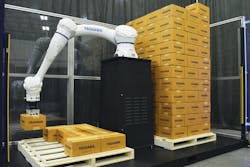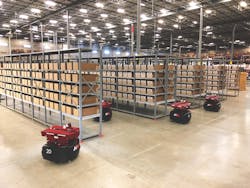You're Hired: Recruiting Mobile Robots
Autonomous robots criss-cross the aisles of mammoth warehouses to retrieve items or stack and unload pallets. Robot arms move parts from one work cell to the next or perform some basic welding. A semi-autonomous control unit and 6-axis robotic arm combo sweeps in to handle COVID-19 disinfection services without endangering human lives.
Say hello to the next-generation robot workforce—a diverse group of highly intelligent mobile robots capable of performing tasks not possible with older robot technology and doing so in direct and safe collaboration with humans. While industrial robots have been part of the automation mix for decades, key advances in sensors, artificial intelligence (AI), software, machine vision, and light detection and ranging (LiDAR), among other technologies, are coalescing to empower an emerging category of more capable mobile and collaborative robots that are easier to program, less expensive to deploy, and far more flexible in the kinds of tasks they can perform. Already, companies are deploying mobile robots to gain efficiencies moving products and materials, to assist in the picking process, to facilitate sorting, and to perform mundane assembly tasks to free up human colleagues to focus on higher-value work.
Challenges raised by the COVID-19 global pandemic have also buttressed interest in integrating mobile robot talent into the existing workforce. Some manufacturers are turning to mobile robots because operations are not safe for their human employees. Others, in catch-up mode after temporarily shutting down operations, are now deploying mobile robots to augment their workforce and maximize plant floor productivity without having to make years-long, multi-million commitments to robotics and automation projects.
“Companies big and small are wrestling with how to come back to full production and still maintain social distancing…and this class of robot can work in close proximity to human workers,” notes Joe Campbell, senior manager, strategic marketing and application development and the head of North America for Universal Robots. “The concept of incremental investment in automation is unique to the collaborative space and we see companies figuring that out—exacerbated by COVID-19.”
Mobile robots are typically classified in one of two categories: 1) Smaller, lightweight robots that can easily move from one line to the next or between work cells and operate safely in close proximity to humans; and 2) autonomous mobile robots (AMRs), which use sensing hardware, software, machine vision, AI, and other technologies to operate with a huge amount of autonomy.
Unlike conventional industrial robots that are generally fixed to a particular line or work cell, perform highly repetitive tasks, and need to be cordoned off behind a cage to ensure safe operation, collaborative robots (cobots) are lighter with more versatility. This new robot class can safely share a workspace with employees, is relatively simple to program and deploy, and can mimic human actions with similar payloads and reach. Cobots are finding work doing repetitive or injury-prone tasks—from palletizing to machine tending. As such, the market for cobots, valued at $649.1 million in 2018, is projected to surge at a calculated annual growth rate (CAGR) of 44.5% between 2019 and 2025, according to Grandview Research. This growth is fueled by advanced innovations, decreasing price tags, and a growing need to have more flexibility in automation.
Autonomous mobile robots (AMRs) are generally considered to be the successor to older automated guided vehicles (AGVs), providing a more flexible, less expensive path to this form of automation (i.e., moving items from point A to point B). AGVs, already well-entrenched workhorses on the shop floor and in warehouses, follow fixed tracks determined by wires, beacons, or magnets. Because they have little on-board intelligence, AGVs are not able to change their route or navigate around obstacles, which means they typically must be relegated to low-traffic or caged areas due to safety concerns. In addition, deployment requires a significant investment in planning and architecting the factory floor layout, which can lead to lengthy and potentially expensive implementations.
Comparatively, AMRs are far more sophisticated, packed with sensors and onboard intelligence that help the robot understand its operating environment and navigate congestion, whether that’s people, pallets, or forklifts. While AGVs are good at repetitive, highly controlled movements and tasks, AMRs are much more dynamic and flexible, and can go anywhere in a facility. Prescient & Strategic Intelligence is predicting the market for AMRs to grow from $29.3 billion in 2019 to $220.6 billion by 2030, fueled, in part, by the expanding e-commerce sector.
“In the past, you had to change the warehouse for an AGV, today with AMRs, the robot adapts to the warehouse,” explains Lior Elazary, CEO and co-founder of InVia Robotics, which markets AMRs with a focus on the e-commerce segment. “When we put railroad tracks around the world, trains became fairly autonomous, but it was very costly to do that. Now we’re building cars that are able to adapt to roads and conditions. That’s what we’re talking about in the warehouse—using AMRs that can adapt, which decreases costs tremendously. At the end of the day, that ties into ROI.”
One of the first caveats for recruiting the right robot is understanding the business problem you are trying to solve—not selecting a particular robot class because the technology is trendy or state-of-the-art. One of the advantages of new mobile robots is that they allow companies to invest in automation incrementally—instead of trying to automate an entire 10-step process with a time-consuming, expensive implementation, they can pick off a couple of steps and augment the human workforce with a cobot, says Universal Robots’ Campbell. “You don’t have to look for a $1 million problem—you can find a series of $75,000 problems because you don’t have to automate everything at once,” he explains. “Because of their collaborative nature, you don’t have to dedicate floor space or build out hard safety barriers and everything else that goes along with traditional automation.”
Once the business problem is defined, it becomes easier to evaluate robot classes and vendor offerings through their respective features and functions. Speed of robot operations, payload constraints, reach, precision, and the gross manipulation motor skills to get the job done are just a few of the criteria that should be in play when evaluating mobile robot candidates, experts say.
Ease of programming and accessibility is another big differentiator. Universal Robots touts its ability for non-experts to quickly learn the fundamentals and program the robot to adapt to solving different tasks. Case in point: A research team at Nanyang Technological University in Singapore is readying for public trial the XDBOT, a semi-autonomous robot that marries a Universal UR5 cobot outfitted with an electrostatic spray nozzle and a mobile AMR platform to disinfect large areas in place of humans.
“Because we’re so flexible and easy to reprogram and redeploy, we see a lot of this use of robot as a tool,” Campbell says. “There’s the ability to mount it on a cart and move it from machine to machine depending on the production load for that day.”
Companies must also consider safety standards as they evaluate the different robot classes and offerings, including a deep dive to determine if the sensing capabilities of a platform map to the kinds of obstacles in a particular environment, explains Melonee Wise, CEO of Fetch Robotics, which makes AMRs. The capabilities of the robotics software and its ability to integrate with core systems and plant floor hardware are a crucial consideration. For example, Fetch recently announced a collaboration with Zebra Technologies Corp., integrating its AMRs with Zebra’s FulfillmentEdge software to support collaborative picking and dynamic workflows that allow workers to spend more time in the aisle instead of manually moving material throughout a facility.
“Not all solutions are equal across AMR providers,” Wise says. “Every product has different levels of integration with fixed automation like conveyors or software like MES systems. You have to look at what the mobile robot provider has in terms of software for connecting to other automation in the plant.”
As part of the selection process, organizations need to look beyond their requirements for a particular project or series of projects and consider the entire lifecycle of a mobile robot, including potential service requirements and changeovers. “You need to consider what is the cost to change over to another solution—is it easy enough to do ourselves within minutes or hours or does it require a lot of effort and cost in terms of servicing the solution,” notes Shermine Gotfredsen, vice president of global sales at ROEQ, a manufacturer of accessory equipment for mobile robots, including carts, top rollers, and conveyors.
The general ease of programmability and flexibility of AMRs compared to older industrial robot generations is enabling a new generation of accessories and integrations that weren’t possible with older robot technology. The resulting expanded ecosystem of add-on products is another factor to consider as manufacturers evaluate different mobile robots. For example, Universal Robot’s ecosystem offers a range of third-party options, including a collaborative robot welding package using technology from ARC Specialties. In another example, ROEQ is offering GuardCom, a system that employs sensors to replace cumbersome and unstable Wi-Fi setups for communicating between conveyor systems, mobile robots, and stationary cargo transfer systems, the goal being to prevent delays and mismanagement when transferring goods between platforms.
“AGV technology requires highly customized accessories, which can create a lot of unreliability,” Gotfredsen says. “There are not as many accessory integration challenges with AMRs.”
Part of the evaluation process means balancing what an organization needs today with what it will need in the future. Many mobile robots are offered via a cloud-based, robots-as-a-service business model, which ensures companies can easily scale to meet future needs. InVia, for example, contracts with customers, not by the number of robots, but rather agreed-upon productivity levels for the robots. “We understand the robots and what they can do and the customer understands how many totes they need to get through the system,” says Elazary. “With robotics-as-a-service, you don’t buy software or robots, you buy productivity.”
As companies move forward with the evaluations and, ultimately, deployments, they need to keep in mind these mobile robots are not a panacea and won’t be a fit for every application. “Many companies don’t realize their parts are not necessarily manufactured for automation or that their stamping process puts out parts that won’t come together easily or that the robot can’t keep up with unplanned production surges or change overs,” says Dean Elkins, segment leader, handling, at Yaskawa Electric’s Motoman Robotics Division. “Don’t assume robots can do more than they can.”



